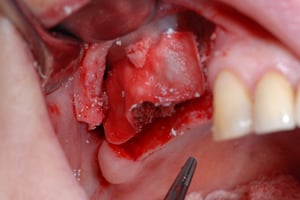 In this article, we will review the uses, types, and advancements in dental grafting materials over the years. This includes biologic and synthetic grafting materials; where to use, what type of material, and the advantages each material offers.
In this article, we will review the uses, types, and advancements in dental grafting materials over the years. This includes biologic and synthetic grafting materials; where to use, what type of material, and the advantages each material offers.
Introduction
Since the beginning of dental surgical time, the general thought process has been one's own bone for grafting is best. After that, the thought was, next to one's own bone, the next best is allograft. If one's own bone or allograft wasn't available, we would then look to synthetics. In past years, synthetics have been missing the mark. As time has gone on, and technology has advanced, this is no longer the case. Synthetics are now of equal quality and efficacy in most respects and, in some respects, better quality and efficacy than others.
What are Grafting Materials Used For?
Dental surgical grafting materials are used for various applications. The most common of these applications is site preservation. Site preservation is placing graft material in a socket to prevent bone loss after extraction. This seems like a common sense application; however, this was not performed until dental implants became commonplace. This is very unfortunate since 30-60% of the alveolar ridge can resorb quickly after tooth extraction.
Another common application of grafting material is sinus augmentation. Once again, this procedure has been born through the world of dental implants. If there is insufficient maxillary height to place an implant, a surgeon can augment the maxilla into the sinus. Essentially, sinus augmentation is using the empty space of the maxillary sinus to grow bone. One does this using a bone grafting material, and the existing sinus membrane using various approaches.
We can also use bone grafting materials to correct defects in bone. To better understand this, let us give a for instance. Let's say one is preparing an implant site. While preparing this implant site, there is a perforation along either the buccal or lingual of the implant preparation. We do not want to graft the entire site with graft material, wait for healing, then come back and do another surgery.
The proper protocol in this situation would rather be to realign the direction of the preparation. Then, place the implant and graft over the threads of the implant with graft material.
Essentially, any time that you want to correct, transform, or preserve the shape of the existing bone, this is when you use bone grafting materials. Bone grafting materials are the workhorse of medicine and dentistry. They do a copious amount of work and get very little credit.
What are the Types of Grafting Materials?
The "oldest" and first types of grafting materials were autografts. This is of no surprise. In the beginning, if you needed a graft and you needed some bone, you just grabbed some from your own body. That is what autograft means, from one own self. But this was not always convenient, nor practical.
The next place we looked for bone was to other people, particularly cadaver bone from deceased donors. We still do in fact. A good part of our grafting material comes from cadaveric tissue. Cadaver tissue is also known as allograft.
Allograft is very functional with good handling but always comes with a risk of disease transmission even thought the risk is very small. In recent years the population was concerned about transmission of disease, especially when HIV first hit the scene in the early 1980s and from recalls of human tissue due to donor screening of cadaver tissue.
This is when we looked at two other material sources. The first of these was Xenografts. Xenografts are grafts from another species. We could use bone particles from bovine (cow), equine (horse), or ovine (sheep).
Then we, as a community started running into some problems with xenografts. There were problems with animal rights organizations with some of these grafting materials. Also, some patients had religious issues with some of these graft materials. Something else had to be found.
We next looked at alloplasts. An alloplast is a synthetic material. Synthetics can simulate the effect of natural bone grafting in the body. The first alloplasts were ceramics in nature. They were essentially just there as space savers until bone could replace them.
They did have moderate handling properties, and they were safe. However, it was found they did not osseointegrate like natural bone products. This is where the big drawback was, and where more research was needed.
How Have Synthetic Grafting Materials Advanced in the Recent Years?
With alloplasts needing some changes, we delved deeper. We put our science to work. From this came polymer-based bone grafting materials, such as polylactic acid, or PLA.
We have also been adding growth factors to our graft materials and our membranes. This essentially tells the cells what to become and to speed healing.
Are Different Grafting Materials Used For Different Applications?
The simple answer to this question is yes. You must recognize if you have any special patient concerns, such as the ones that we mentioned earlier. This leads to my next question and answer of how to determine the best grafting material for the application.
How Do I Determine the Best Grafting Material for my Application?
One needs to recognize how long the graft material needs to perform. Natural bone, such as allograft and xenograft tend to not stick around as long as alloplasts. Synthetic membranes can have a variable life depending on manufacturer and construction.
Conclusion
From what you have seen, it may be easy to think to just use alloplasts for everything. While that would be nice, we are not quite there, we are hoping to be there soon! Natural bone tissues still have their place.
Bone grafting materials are in an amazing place right now. Biologic research is in an amazing place right now. With more people having an awareness about their health than ever before, it is much easier to research these materials. Bone grafting materials will only get better. Their osseointegration will get better. Their handling will get better. All leading to more successful surgery, and better patient care.
